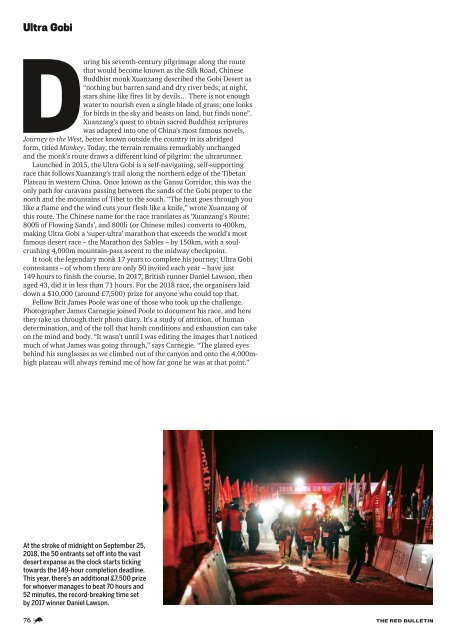Create successful ePaper yourself
Turn your PDF publications into a flip-book with our unique Google optimized e-Paper software.
Ultra Gobi<br />
During his seventh-century pilgrimage along the route<br />
that would become known as the Silk Road, Chinese<br />
Buddhist monk Xuanzang described the Gobi Desert as<br />
“nothing but barren sand and dry river beds; at night,<br />
stars shine like fires lit by devils… <strong>The</strong>re is not enough<br />
water to nourish even a single blade of grass; one looks<br />
for birds in the sky and beasts on land, but finds none”.<br />
Xuanzang’s quest to obtain sacred Buddhist scriptures<br />
was adapted into one of China’s most famous novels,<br />
Journey to the West, better known outside the country in its abridged<br />
form, titled Monkey. Today, the terrain remains remarkably unchanged<br />
and the monk’s route draws a different kind of pilgrim: the ultrarunner.<br />
Launched in 2015, the Ultra Gobi is a self-navigating, self-supporting<br />
race that follows Xuanzang’s trail along the northern edge of the Tibetan<br />
Plateau in western China. Once known as the Gansu Corridor, this was the<br />
only path for caravans passing between the sands of the Gobi proper to the<br />
north and the mountains of Tibet to the south. “<strong>The</strong> heat goes through you<br />
like a flame and the wind cuts your flesh like a knife,” wrote Xuanzang of<br />
this route. <strong>The</strong> Chinese name for the race translates as ‘Xuanzang’s Route:<br />
800li of Flowing Sands’, and 800li (or Chinese miles) converts to 400km,<br />
making Ultra Gobi a ‘super-ultra’ marathon that exceeds the world’s most<br />
famous desert race – the Marathon des Sables – by 150km, with a soulcrushing<br />
4,000m mountain-pass ascent to the midway checkpoint.<br />
It took the legendary monk 17 years to complete his journey; Ultra Gobi<br />
contestants – of whom there are only 50 invited each year – have just<br />
149 hours to finish the course. In 2017, British runner Daniel Lawson, then<br />
aged 43, did it in less than 71 hours. For the 2018 race, the organisers laid<br />
down a $10,000 (around £7,500) prize for anyone who could top that.<br />
Fellow Brit James Poole was one of those who took up the challenge.<br />
Photographer James Carnegie joined Poole to document his race, and here<br />
they take us through their photo diary. It’s a study of attrition, of human<br />
determination, and of the toll that harsh conditions and exhaustion can take<br />
on the mind and body. “It wasn’t until I was editing the images that I noticed<br />
much of what James was going through,” says Carnegie. “<strong>The</strong> glazed eyes<br />
behind his sunglasses as we climbed out of the canyon and onto the 4,000mhigh<br />
plateau will always remind me of how far gone he was at that point.”<br />
At the stroke of midnight on September 25,<br />
2018, the 50 entrants set off into the vast<br />
desert expanse as the clock starts ticking<br />
towards the 149-hour completion deadline.<br />
This year, there’s an additional £7,500 prize<br />
for whoever manages to beat 70 hours and<br />
52 minutes, the record-breaking time set<br />
by 2017 winner Daniel Lawson.<br />
76 THE RED BULLETIN

















